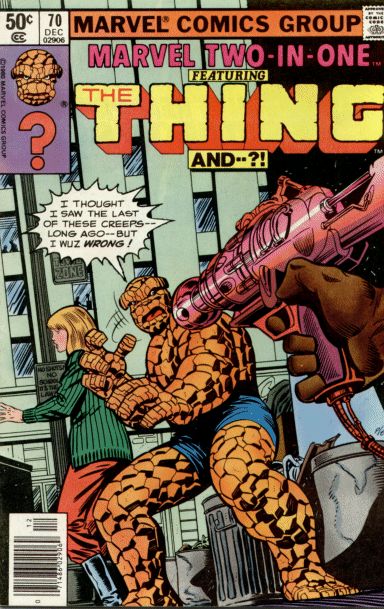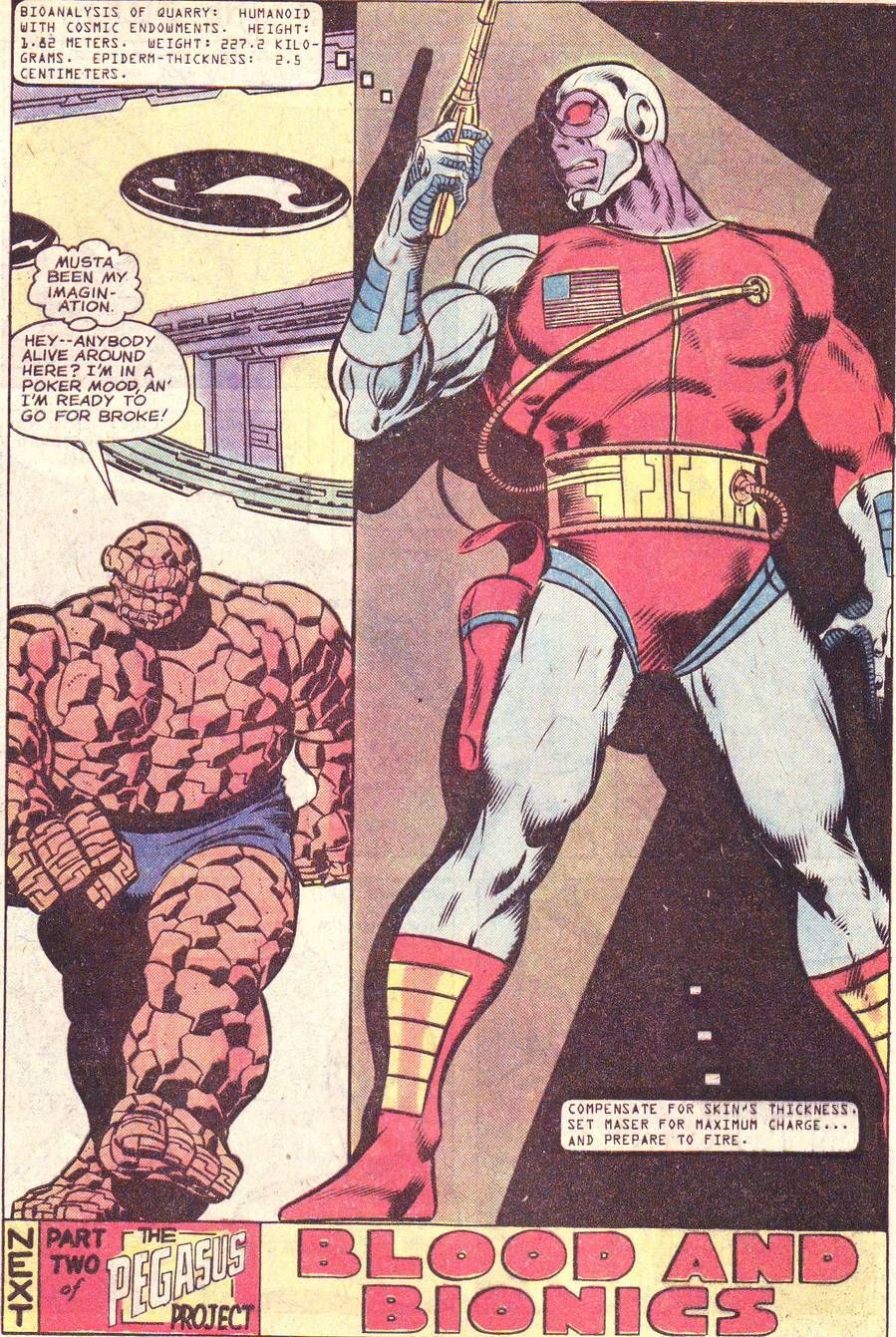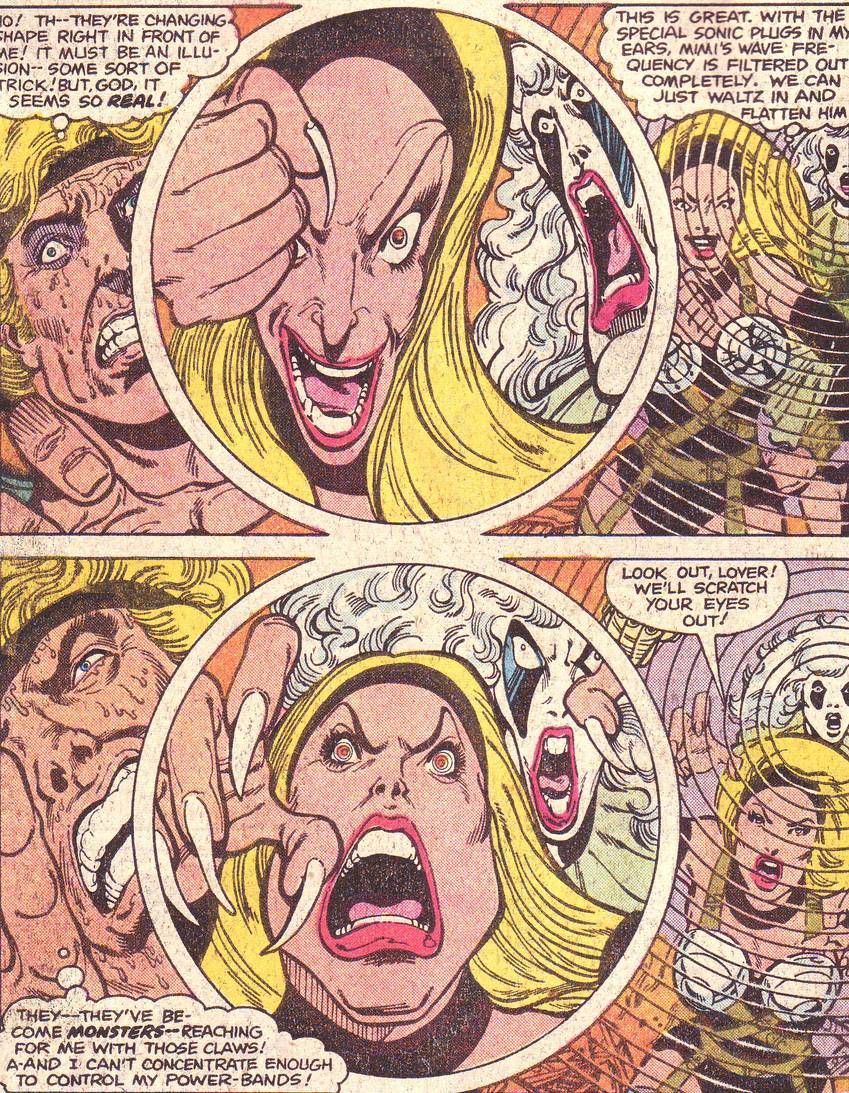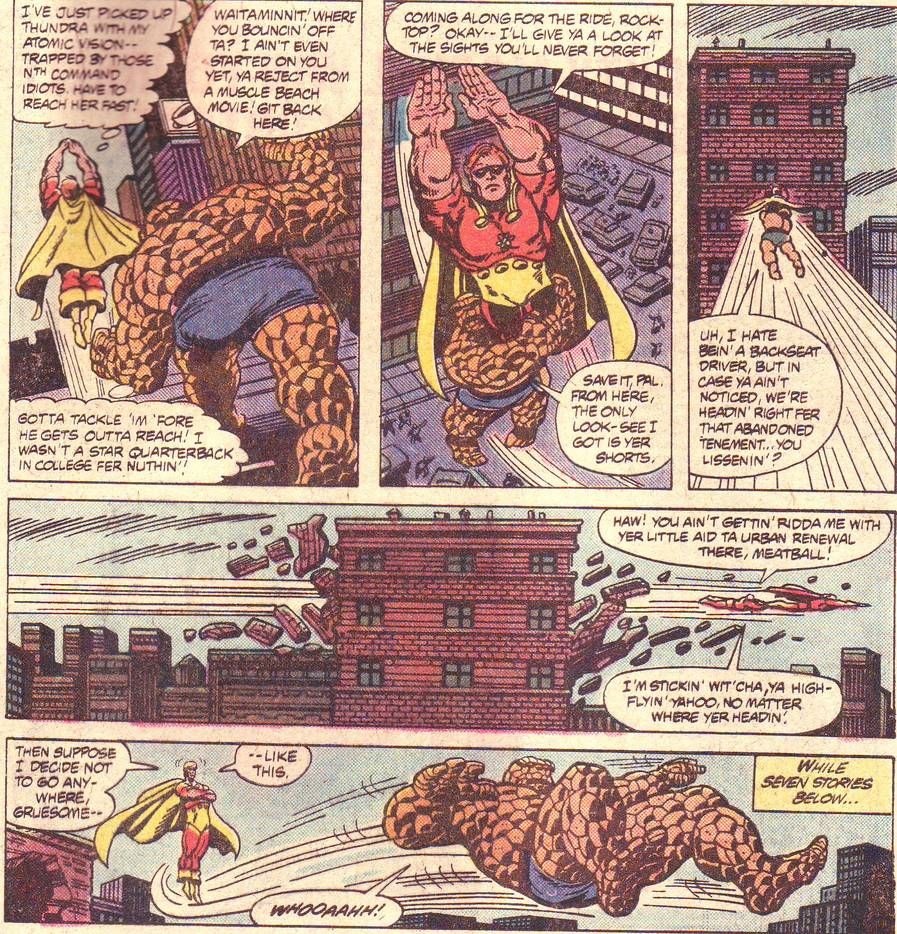Numbers 15-14 and explanation here. Numbers 13-11 are over here somewhere.
So. hey, top ten, here, now! But first let me explain a little bit about how the list is put together.
The runs are generally "scored" based on the following loose criteria, listed in order of importance.
1) Quality of craft. Are these comics well written and well drawn (and less importantly, well inked, colored, even lettered/) Are they doing something unique and original?
In general, I'll score a run that's uneven - with some spectacular highs and some outright failures - higher than a run that's consistently good but not "OHMY%^&*ING GOD!" A bunch of Ds and As will likely be scored higher than a similar grouping of Bs and Cs.
2) Are the runs critically well received and well remembered? Are they talked about a lot? Are they mentioned in the comments?
This criteria cost the Tom Defalco Two-In-One run three or four slots. I couldn't find a decent link to anyone talking about them at all except for Annual # 7.
3) Is the run considered historically important?
4) Are they considered a major work in a specific artists' career?
5) Do they have team-ups, villains, and supporting characters that I, personally, think are cool? Yeah, it's completely subjective. This rule is a little reward to myself for doing all this freakin' scanning.
So, into the top ten, starting with:
10) Mark Gruenwald and/or Ralph Maccio (writers) on Marvel Two-In-One (1979-1981)
Issues: 53-58, 60-74 (21 issues) Ron Wilson, John Byrne(!), George Perez(!!), Jerry Bingham, Frank Springer and Mike Nasser artists.
Team-Ups: Quasar, Deathlok, Bill Foster(Giant-Man), Wundarr/Aquarian, the Impossible Man, Starhawk, Moondragon, Warlock-except-not-really, Stingray, Triton, Scarlet Witch, Hyperion, Angel. the Guardians of the Galaxy, Mystery Guest, Mr. Fantastic, the Inhumans, and the Puppet Master.
Reasons Why This Run Rocks:
1) The art. These issues provide the the absolute best eye-candy in all of MTIO. You got your John Byrne
(From Marvel Two-In-One # 53. Joe Sinnott inker.)
Your George Perez
(From Marvel Two-In-One # 56. Gene Day co-artist.)
and... I'll get back to the art later.
2) Long term planning. Recurring locations! Villains who aren't defeated after one issue, or even one arc! Multi-part stories! Ongoing subplots, people! ONGOING SUBPLOTS!
This is the most modern-feeling run on the list. While yer average team-up book is going to score between "little" and "none" in the issue-to-issue continuity department, Ralph and Gru's MTIO is just suffused with the stuff. It kicks off with "Project Pegasus" a big 'ol six issue arc dealing with shenanigans at a government sponsored supervillian containment project. Now six issues might not sound like a noteworthy event in these decompressed days, back in the 'early '80s a story this long was rarity. The letter pages in later issues strongly imply that this was heavily hyped and considered a pretty damn big deal. And it worked as a big event, setting up story-lines that would play out throughout the rest of the run. p. The whole thing felt quite a bit like a modern dramatic TV show. Not every issue was part of the overall story-arc, but there was a larger story being constructed if you were patient.
3) The art! Man, even Ron Wilson who I bagged on before knocks it outta the park.
(From Marvel Two-In-One # 67. Gene Day and "friends" inker.)
4) The team-ups: I love, love, drooly-tounge-kiss-nose-rub LOVE all these funky team-ups. No Spider-mans, Hulks, or Wolverine here! It's all Thundra, the Impossible Man, and (Huzzah!) Wundarr! baby! The closest thing to a major guest star is Mr. Fantastic, or maybe the Scarlet Witch. I also dig how many of these guys have previous ties to the Fantastic Four, making it feel a bit like old-home week. And there's a mystery guest, and a villain team-up with the Puppet Master, two of my favorite special categories of teams. (But ONLY when the villain team-up is done right and the villain and the hero actually work together -as they did here. Otherwise it's cheating.)
5) The Art: Man, I can't remember seeing Jerry Bingham's art before (I am old, and my brain is sort of mushy) but he's firing on all cylinders here. There's a slightly earthier John Buscema look to his stuff. I'm also really appreciating the consistency of Gene Day's inking on most of these issues - It helps a lot to make this run feel like part of a whole. And dig the shading in this panel below. Creepy.
(From MTIO # 66. Gene Day inker.)
On the Other Hand: You notice how I've been concentrating on the art here? It's 'cause quite a few of these issues have major story flaws. The Project Pegasus arc doesn't feel like there's quite enough story to fill six non-decompressed issues. The Inhumans story is the opposite. It's four issues (plus) of comics in a two issue bag, and the writers have to jam every available nook and cranny full of expository text just to work through all the plot - Which, come to think, is true of the Warlock three-parter as well. And there's the Impossible Man story which is 16 pages of awesome and an ending that *POPUPS* outta nowhere, and doesn't relate back to the rest of the story. None of these comics are awful- There's SOMETHING cool, or more often four or five cool somethings in every issue - But there are a lot of individual writing hiccoughs as well.
Sidenote: I said a run had to be five issues. I THOUGHT Brennert wrote five issues, until I looked at the credits to # 184. Which is a pretty great Earth-Two Huntress team-up written, sadly, by Mike W. Barr. But this stuff is SO important and influential that I'd feel like my list wouldn't really work without it there. So I'm leaving within.
9) Alan Brennert (writer) on Brave and the Bold (1981-1983)
Issues: 178, 181-182, 197 (4 Issues) Jim Aparo and Joe Staton artists.
Team-Ups The Creeper, Hawk and the Dove, Earth-Two Robin, and Earth-Two Batman with Earth-Two Catwoman. Yep. 100% Steve Ditko and E2 Batfamily. Way to find a niche and work it, Alan!
Why This Run Rocks: C-h-a-r-a-c-t-e-r-i-z-a-t-i-o-n. More than any other team-up book writer - and more than 98% of comic writers in general - Brennert wrote characters who acted like real people. Brennert's specialty is the flawed hero - Not gun-toting psychopathic anti-heroes, but genuinely good folks who are just ever-so-slightly-messed-up: Angry, (Hawk) neurotic, (Dove), prejudiced, (Clayton Wetley, the villain from "Paperchase") scared, (Batman, of all people) and then there's EVERYONE from "Interlude on Earth-Two" which we'll get to in a sec. And the heroic victory over adversity is far from garuanteed. They might recover and conquer their weaknesses, OR they might be consumed and torn down by 'em, as Hawk and the Dove were. Brennert went out of his way to avoid the simple moral tropes of heroic fiction, and that's why we're still fighting about these stories today. (See below.....)
(From Brave and the Bold # 181)
2) Since Greg Hatcher already talked about this:
Because the power in this story comes from Alan Brennert's willingness to explore the sheer weirdness of how it would be to meet a parallel-earth doppelganger of a person you've known for years and have them almost be the same... but not entirely. It works especially well here because at this point in the larger DC continuity, Paul Levitz had just killed off Earth-2's Batman, which allowed Alan Brennert to do a story showing a Robin and Batwoman that were still raw with grief over it.
The whole story is about acceptance and letting go, it's the lesson everyone has to learn by the end. Even nasty old Hugo Strange. All that and it's still a rousing Bat-adventure, too.
Right. Brennert was the first guy to realize that this whole "Alternate Universe" thing - The idea that there's another person out there who's almost you... Except maybe evil, or dead, or a superhero - Is really fairly terrifying, and could scramble up your mind right proper.
(From Brave and the Bold # 182)
3) Everyone hard-core nerd who's aware of this run has a favorite A B written B 'n B story. But very rarely do two people have the SAME favorite Alan Brennert team-up. Well... sort of. There are only five of them. I'm a "Paperchase" guy, myself - The Creeper team-up which features a combination of two of my favorite superhero tropes: Heroes vs. metaphor for universal evil (In this case intolerance and prejudice) and heroes defeat their enemies with KICKING and FIRE. (And, Ok, some personal revelation of the part of the story's villain and blah...blah...blah. But mostly KICKING and FIRE. Take that Evil! Right in the GUT!)
But I don't expect anyone to agree with me.
On the other hand: 18 pages. 19. 23 at the absolute MAX. This complaint isn't so much about Brennert as a writer as it is with the format. But Brennert's overwhelming emphasis on building and defining his charactters meant that the plots here could be a little... perfunctory. Hawk and Dove fight generic thugs. Batman and the Catwoman overcome their Scarecow induced fears and.... the Scarecrow gets captured off-panel. Every issue here would work just fine as a three issue mini-series, thinks I, but in their current form they're cramped for space.
And while I appreciate the Bob Haney-ness of just tossing a new character in at random with no regards to continuity but... Why the Hell is there an Earth-Two Batwoman?! Does this mean all of Batman's '50 and early '60s stories happened on Earth-Two AND Earth-One? How does that reconcile with the darker tone of what Brennert's doing here.
This is the sort of thing that keeps me awake at nights. Pity, PITY the uber-nerd.
Bonus Link! Here's more from Greg Hatcher on B&B 182.
And here's Scott (Of the Classic Comics Corner) the Four Famous Co-Stars B &B review page on # 197.
Next:
Join me Saturday-ish for the one run y'all will NEVER GUESS EVER.
And another one you already did in the comments. More than once. I thought no-one would mention it but now the surprise is ruined and I hope you're happy.
Next time.






